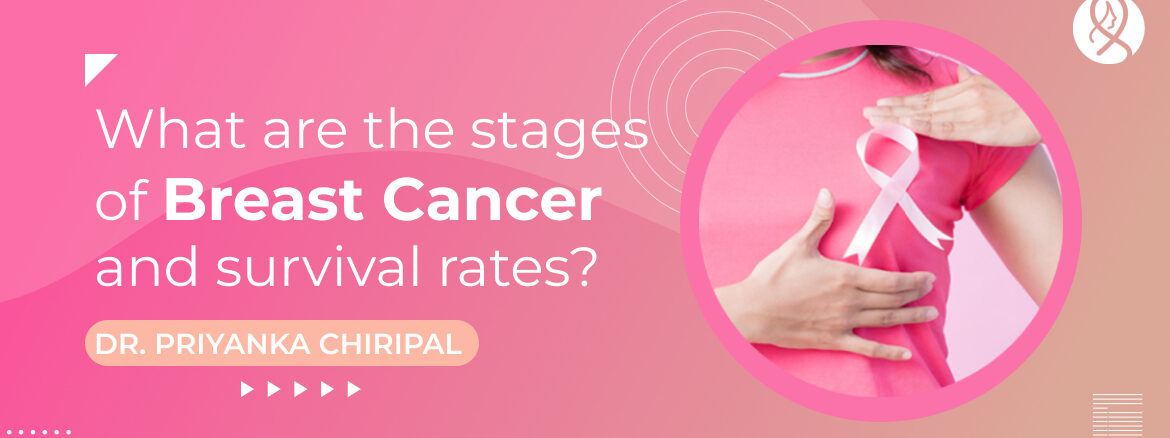Introduction
Breast cancer is a complex disease that affects millions of women worldwide, with approximately one in eight women affecting with the disease in their lifetime. Although getting affected and receiving breast cancer treatment can be frightening, it’s important to know that survival rates have increased over time as a result of improvements in detection and treatment. The stage of cancer, the patient’s age, and the characteristics of the tumor are only a few of the variables that affect the prognosis for breast cancer. We will talk about the various stages of breast cancer and the corresponding survival rates in this blog post.
Understanding the Stages of Breast Cancer
Stage 0: DCIS
Ductal carcinoma in situ, also known as DCIS, is the initial stage of breast cancer. At this point, lymph nodes or surrounding tissues are not yet affected by the cancer because it is still confined to the milk ducts. DCIS is not life-threatening but if untreated, it can progress to invasive breast cancer. DCIS is normally treated with surgery to remove the abnormal cells, radiation therapy, and occasionally hormone therapy to lower the chance of recurrence. The good news is that the survival rate for Stage 0 breast cancer is very high, with most women going on to live a normal lifespan after treatment. For stage 1 breast cancer, the five-year survival rate is roughly 100%.
Stage 1: Early-stage breast cancer
Breast cancer in its early stages is those that have already infiltrated adjacent breast tissue but have not yet migrated to other organs or lymph nodes. Stage 1A and stage 1B are the two subgroups of stage 1 breast cancer. Stage 1A tumors are tiny (less than 2 cm in diameter) and do not have lymph node involvement. Stage 1B tumors can be small (less than 2 cm), but they may have spread to surrounding lymph nodes, or they can be larger (between 2 and 5 cm), but they may not have done so.
For stage 1 breast cancer, the five-year survival rate is roughly 99%.
Stage 2: Locally advanced breast cancers
This stage of cancer migrates to neighbouring lymph nodes and encroached on nearby breast tissue. Stage 2 is further separated into Stage 2A and Stage 2B. Stage 2A tumors are smaller (less than 2 cm), have spread to surrounding lymph nodes, or are between 2 and 5 cm in size without having done so. Stage 2B tumors range in size from 2 to 5 cm and have spread to adjacent lymph nodes, or they are larger than 5 cm but have not yet done so.
Approximately 93% of stage 2 breast cancer patients survive for at least five years.
Stage 3: Advanced breast cancer
Advanced breast cancer refers to the spread of cancer cells outside of the breast tissue and adjacent lymph nodes to other bodily regions. Three subcategories of stage 3 are: stage 3A, stage 3B, and stage 3C. Stage 3A tumors might range in size and have spread to surrounding lymph nodes, some of which may have gathered. In stage 3B, the tumour may have grown to any size and spread to the breast skin or chest wall. Stage 3C tumors might be of any size and have migrated to lymph nodes close by, either above or below the collarbone.
For stage 3 breast cancer, the five-year survival rate is roughly 72%.
Stage 4: Metastatic breast cancer
Metastatic breast cancer cells spread to the lungs, liver, bones, or brain, among other organs. Although stage 4 breast cancer cannot be cured, it can be treated, and the aim of treatment is to prolong and enhance quality of life.
For stage 4 breast cancer, the five-year survival rate is roughly 22%.
The stage of the cancer, the patient’s age, general health, and the kind of breast cancer are some of the variables that affect breast cancer survival rates. Every case is different, and survival statistics are not a reliable indicator of an individual’s prognosis.
Elements that may affect the diagnosis for breast cancer:
- Status of hormone receptors: Breast cancer cells may have HER2, progesterone, or estrogen receptors. Hormone therapy typically works better on tumors that test positive for hormone receptors.
- Tumor grade: Under a microscope, tumor grade defines the visual differences between malignant and healthy cells. A higher grade indicates more cancerous cells that are abnormal and more likely to grow and spread quickly.
- Age: Younger women typically experience more aggressive breast cancer.
- General health: It may be harder for patients with other illnesses to tolerate cancer treatment.
It’s crucial to get treatment from a breast cancer surgeon who is certified and skilled if you have been diagnosed with breast cancer. Depending on the stage and characteristics of the cancer, the treatment for breast cancer often combines surgery, radiation therapy, chemotherapy, targeted therapy, and hormone therapy
Summing Up
To sum up, breast cancer is a complicated illness that develops into various phases, each of which has unique traits and implications for therapy and survival. The stage of the cancer, the patient’s age, general health, and the kind and stage of breast cancer are some of the variables that affect survival rates. For individualized treatment advice and assistance, speak with a breast cancer surgeon. Many breast cancer patients can experience enhanced quality of life and long-term survival with prompt and suitable therapy.



